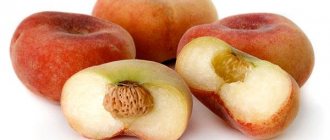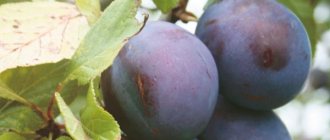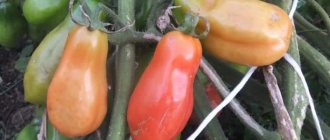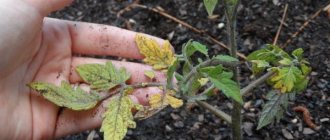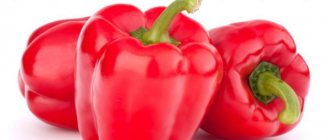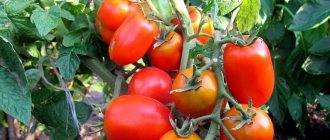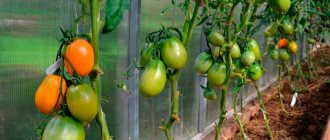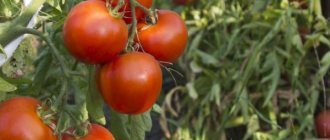Description of the tomato variety Heavyweight of Siberia, its characteristics and growing region
Tomato Heavyweight of Siberia is one of the successful developments of the team led by Vladimir Nikolaevich Dederko. He and his colleagues, most often O.V. Postnikova and A.A. Yabrov, working in agriculture, created many varieties of tomatoes that thrive both in Siberia and in many other regions. This also applies to the variety Heavyweight of Siberia, included in the State Register of Breeding Achievements of the Russian Federation in 2007 and recommended for private farms in all regions of the country. The variety is intended for cultivation in open ground.
The heavyweight of Siberia is a representative of determinate varieties, grows in the form of a low bush (no more than 70 cm) with medium-sized green leaves. Despite the compactness of the plant, it has to be tied up, which is due to the massiveness of the fruits. According to its intended purpose, the variety is a salad variety, and according to its ripening period, it is early ripening: the first fruits ripen a little over three months after full germination. It is highly resistant to cold and most diseases. At temperatures above 30 ° C, the yield decreases sharply, therefore, despite the absence of official restrictions regarding growing regions, Heavy of Siberia is rarely planted in the south.
Appearance of tomatoes
The heavyweight of Siberia is a typical representative of heart-shaped tomatoes with an interesting crimson color. The shape of the fruit is quite regular, although there are barely noticeable ribs. In terms of size, most of the fruits on the bushes can be classified as large, although far from gigantic. The appearance of the fruits suggests that they are very tasty fresh, and this turns out to be true.
The fruits are surprisingly beautiful, without cracks or other irregularities
Harvesting and application
Tomatoes are harvested 95-100 days after planting in the ground. Ripe fruits can be eaten either fresh or prepared into juices, pastes, stews, etc. Not suitable for pickling, as the fruits are too large.
Note! The variety can be consumed by people with gastrointestinal problems, since this tomato contains few acids.
Advantages and disadvantages, differences from other varieties
A distinctive feature of the Siberian Heavy tomato is the shape and color of the fruit, although similar options exist. So, this variety can be confused with the wonderful variety of Novosibirsk breeders Velmozha. Both of them have a lot of advantages. The main advantages of the variety in question are as follows:
- very high cold resistance;
- magnificent appearance of the fruit;
- excellent taste;
- early ripening coupled with duration of fruiting;
- good transportability of the crop;
- unpretentiousness to growing conditions;
- high disease resistance.
The big disadvantage of the variety is its low yield, both per bush and per unit area. Another disadvantage can be considered the low heat resistance of the variety. The impossibility of whole-fruit canning, noted by some gardeners, can hardly be attributed to a disadvantage: there are a huge number of other good varieties for this purpose. After all, the purpose of the Heavyweight of Siberia is to please the owner with delicious fresh fruits already in the first half of summer.
In many characteristics, this variety really resembles Velmozh. True, the Velmozha variety is recommended for a limited number of climatic regions and is distinguished by a slightly smaller fruit size. The shape of the fruits is similar to the wonderful Siberian variety Danko, but Danko’s tomatoes are red. Generally speaking, there are quite a lot of heart-shaped tomatoes, and many of them are large-fruited. The Altai honey tomato is recognized as one of the best, but it is intended for greenhouse cultivation. The Angelina variety has very tasty fruits, but they are smaller.
Features of growing tomatoes Heavyweight of Siberia
Tomato Heavyweight of Siberia, like other varieties with low bushes, is rarely grown in greenhouses. As a last resort, you can use temporary film shelters for the first time after planting seedlings, if real warmth has not arrived by the usual time. Established plants tolerate cold well, but, of course, not frost. Cool weather, if it does not last for a very long time, does not even affect the final yield of the variety and the taste of the fruit, unlike prolonged abnormal heat.
Basically, this tomato is grown through seedlings, for which the seeds are sown in boxes or pots at the usual time - in the second half of March. Caring for seedlings has no special features; moreover, if the summer heat lingers, you can keep them in the apartment for a week or two, they will not stretch out. True, it will most likely bloom, therefore, in order not to lose the first harvest, seedlings should be transplanted into the garden bed very carefully, without disturbing the root system. 4–5 bushes are planted per 1 m2.
Tomato seedlings Heavyweight of Siberia are not prone to overgrowth
The regime of watering and fertilizing for the variety Heavyweight of Siberia is normal, and the formation of the bush does not present any difficulties. More precisely, it may not be carried out at all. Only if you want to get especially large tomatoes do you plant them and remove excess ovaries (leave no more than a dozen per bush). But it is advisable to tie up not only the stem, but also the fruit clusters. Some gardeners place spears under the brushes, almost like under the branches of fruit trees.
Tomato care
The heavyweight of Siberia loves water and is watered abundantly. Photo: ogorod.ru The Siberian Heavyweight is afraid of long droughts. Therefore, it is watered abundantly:
- Before the flowers bloom, the bushes are irrigated every 7 days. One plant should receive half a bucket (5 liters) of moisture.
- When the crop blooms, it is watered 2 times a week. There should be 3 liters of water per bush.
- When the fruits ripen, tomatoes are watered every 7 days. No more than 3 liters of water is poured under each plant. Otherwise, the fruits will be watery and may begin to crack.
Loosening the soil improves access to moisture and air to plant roots.
Photo: otomatah.ru After rain and irrigation of the tomatoes, the root zone of the bushes is cleared of weeds and loosened. This improves air and moisture exchange, as well as the plants’ receipt of nutrients. To reduce the number of waterings, beds with tomatoes can be mulched with sawdust, straw, peat or other organic matter.
Ready-made mineral complexes contain all the substances useful for tomatoes. Photo: lapo4ka.com
During the season, tomatoes are fertilized:
- Before blooming, tomatoes are fed with an infusion of cow manure, bird droppings or field herbs. Each bush should have 5 liters of solution.
- When the fruits ripen, tomatoes are fertilized with a mixture of superphosphate and potassium sulfate. In this case, 45 g of each composition are added to 10 liters of water.
It should be noted that the heavyweight of Siberia is cultivated without pinching. Therefore, to obtain the largest possible fruits, excess buds on the bushes are pinched.
To prevent branches with large tomatoes from breaking, the bushes need to be tied to supports. To do this, a wooden stake or metal pin is driven close to the plant. All loaded fruit bearings are tied to them.
The fungicide will prevent the tomatoes from getting sick. Photo: babudacha.ru
The Heavyweight of Siberia has good immunity to disease. However, for the purpose of prevention, its bushes must be sprayed with fungicides 2–4 times per season:
- Folk remedies include infusions of wormwood, garlic or onion peel.
- Among the industrial preparations suitable for processing tomatoes are Acrobat, Zaslon, Agat-25/K, Luna-Tranquility, Fundazol, Bordeaux mixture, Fitosporin.
Reviews of tomato Heavyweight of Siberia
I grew this variety from the Siberian Garden in 2014 in a greenhouse. I liked it for its early ripening, large fruit and taste. But short stature is a minus for a greenhouse. This year I will plant it again in the greenhouse, but only between tall and thicker ones, as soon as 5 fruits are formed on the bush, I will remove the flower stalks of the stepsons and growing points in the hopes of getting a very early harvest of large tomatoes. Then I will cut the stem at the root and let the tall ones run wild.
Verusha
https://forum.prihoz.ru/viewtopic.php?t=6965&start=30
I've been growing it in OG for several years now. Always behaves like a tall indet, productive, early, tasty, and tastes slightly different from other SibSadov hearts. But in 2014, it was lost due to extreme heat, all that I managed to remove one or two brushes before the heat (up to +50), but when the summer is not so hot, the harvest is always at its best.
Alice
https://www.tomat-pomidor.com/forums/topic/3242-%D1%82%D1%8F%D0%B6%D0%B5%D0%BB%D0%BE%D0%B2%D0%B5 %D1%81-%D1%81%D0%B8%D0%B1%D0%B8%D1%80%D0%B8/
The fruits seem to be large, but the overall yield was not encouraging - clearly below average. At the same time as the Heavyweight of Siberia, I planted Danko, which is all the more interesting since their declared characteristics are similar. I liked Danko much more; among the low-growing heart-shaped ones, I settled on him.
Sasha
https://www.tomat-pomidor.com/forums/topic/3242-%D1%82%D1%8F%D0%B6%D0%B5%D0%BB%D0%BE%D0%B2%D0%B5 %D1%81-%D1%81%D0%B8%D0%B1%D0%B8%D1%80%D0%B8/
One variety really amazed me - this is the Heavyweight of Siberia. I planted them last year, good tomatoes, conical-heart-shaped fruits. There were a lot on the bush, but not very large ones. In the same year, which was very unfavorable in all respects - it was planted late, there were night frosts for a long time, there were large differences in day and night temperatures, and it produced huge fruits weighing 400 - 500 grams. The largest from this bush was 740 gr. I grow it in a greenhouse. The bush is not flimsy, but not a monster either, it does not take up much space. It is weakly affected by cladosporiosis.
Quail
https://www.forumhouse.ru/threads/220157/page-4
This year I planted the tomato Heavyweight of Siberia from SibSad. Damn good! With a bush height of 0.6–0.8 m, it produces fruits up to 500 g when formed into a bush, and in 1 stem - up to 800 g, heart-shaped, without blemishes, pearl-pink beauty, highly leafy and absolutely not responsive to temperature changes. A real Siberian!
Lyuba
https://forum.vinograd.info/showthread.php?p=214966
Pests and diseases
Due to their short stature, plants often suffer from root rot. Experts advise sticking to the tomato planting plan, plucking off the bottom 2-3 leaves in a timely manner and promptly removing weeds from the garden.
Spraying plants with potassium permanganate (2 grams per 12 liters of water) 20 days after planting, and then 2 weeks later with a solution of vitriol (100 grams of copper sulfate and lime per 12 liters of water) will help get rid of late blight infection.
See also
Description of the Black Heart of Breda tomato, characteristics and recommendations for growing
Read
The tobacco mosaic virus can be excluded if the seeds are pre-soaked for half an hour in a solution of potassium permanganate before planting. To do this, you need to dilute 10 grams of the substance in 1 liter of water.


